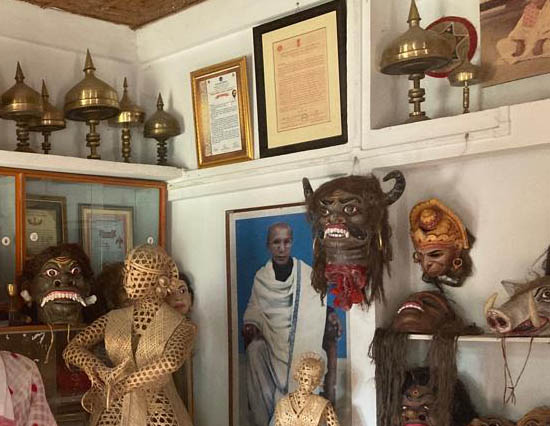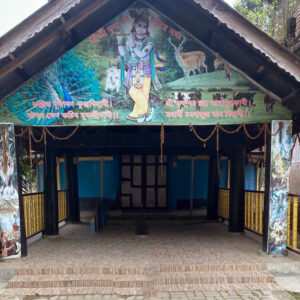Chamaguri Satra, located in the heart of Majuli, Assam, is one of the most renowned Sattras (Vaishnavite monasteries) on the island, famous for its unique contribution to Assam’s cultural and religious heritage. Established in the 16th century by Guru Shree Shree Pitambardev Goswami, this Satra holds a special place in the Vaishnavite movement initiated by Srimanta Sankardev, who propagated Bhakti (devotional) culture in Assam.
Table of Contents
Iconic Mask-Making Tradition
What truly sets Chamaguri Satra apart from other Sattras is its world-renowned tradition of mask-making, a vibrant art form that has been passed down through generations. These masks, used in the performance of Bhaona (a form of traditional drama initiated by Sankardev), are made from bamboo, clay, and cloth. The masks represent various mythological characters from Hindu epics like the Mahabharata and Ramayana.
Artisans of Chamaguri Satra craft these masks with exceptional skill, creating vivid and lifelike representations of gods, demons, and animals. The masks are lightweight yet intricately detailed, making them essential elements of Bhaona performances, which are both religious and artistic expressions of devotion.
Religious and Cultural Importance
Like other Sattras in Majuli, Chamaguri Satra serves as a center for spiritual learning and religious rituals. The Satra is devoted to spreading the teachings of Vaishnavism, particularly the philosophy of Bhakti or devotion to Lord Krishna. Daily prayers, devotional songs, and teachings take place within the Satra, attracting both local devotees and visitors from across the region.
Additionally, Chamaguri Satra plays an integral role in preserving Assam’s classical dance form, Sattriya, which is one of India’s eight classical dance forms. The monks, known as Bhakats, not only practice Sattriya but also teach it to young disciples, ensuring that the art form continues to thrive.
Contributions to Tourism and Cultural Exchange
Chamaguri Satra has gained international recognition for its craftsmanship in mask-making. Tourists and art enthusiasts visit the Satra to witness firsthand how these masks are crafted and to understand their significance in Assam’s cultural tapestry. The popularity of these masks has spread beyond Assam, with Chamaguri Satra exporting them to other parts of India and even abroad.
The Satra is also actively involved in cultural exchange programs, where artisans and performers showcase Assamese traditions on both national and international platforms. This has helped spotlight Majuli as a cultural hub and increase awareness about the island’s rich artistic heritage.
Challenges and Preservation Efforts
Like many other parts of Majuli, Chamaguri Satra is under threat from erosion caused by the Brahmaputra River. The ongoing land loss has displaced several Sattras in Majuli, forcing them to relocate to other parts of the island. Despite these challenges, efforts are being made by local communities, the government, and cultural organizations to protect the Satra and its rich heritage.
Conclusion
Chamaguri Satra stands as a beacon of Assam’s spiritual and artistic legacy. Its contribution to mask-making, traditional Bhaona performances, and the preservation of Sattriya dance makes it a vital cultural institution not only in Majuli but across India. As Majuli continues to grapple with environmental challenges, Chamaguri Satra’s role in preserving and promoting Assam’s heritage remains crucial.
This living treasure not only sustains ancient traditions but also fosters cultural exchange, ensuring that the artistry of Majuli reaches beyond its borders.




